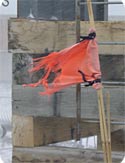|
|

|
|

|
A
wind-whipped flag at McMurdo. Click for a larger image.
|

|
|
|
|

|
|
Finally,
Some Real Antarctic Weather
|

|
p.
2
Predicting
the weather in Antarctica is challenging. Like weather forecasters
everywhere, Jim and Clyde depend on observations from remote
sites and satellites to help them with their computer models.
But there are only 13 weather observation stations on the
continent, and the polar weather satellites don’t provide
continuous coverage (they go out of sight for a couple of
hours every afternoon).
That means that weather can sneak up on Antarctica, sometimes
with little warning. The station does have a new experimental
weather model developed for them by the National Center for
Atmospheric Research in Boulder, Colorado, but the model needs
accurate and sufficient data to make good predictions. Still,
Chester told me it’s performing well in smaller windows,
although accurate 5-day weather forecasts remain a dream here.
In the short term, veterans take weather predicting into their
own hands when they venture out on the ice. Because most of
the storms come from the Ross Sea to the south, the savvy
ice travelers tend to look to "Hurbie Alley" for
dark clouds that signal bad weather is on the way. Hurbie
Alley is located in a gap between two local landmarks, the
somewhat unimaginatively named Black Island and White Island.
When I asked why it was called Hurbie, our sea ice instructor
said it was named for the hurricane force winds that blow
through it. Whatever the reason, Hurbie Alley is where the
storms funnel onto the sea ice surrounding McMurdo, and when
you see one coming you have only an hour or two to make it
back to town.
Another weather phenomenon unique to Antarctica is katabatic
wind. Katabatics are gravity-assisted winds that flow down
the ice from the middle of the continent. They start when
a high-pressure system develops in the high plateau and air
starts spilling down the sloping continent, warming and quickening
as it moves. On the clearest of blue-sky days, these winds
can descend down to the coastline and whip into McMurdo. Karen
Joyce told me she was once running along the sea ice road
to the Willie Field airstrip when a katabatic came in and
she was thrown off her feet. She only managed to keep from
skidding along the ice by grabbing one of the flags that mark
the road and hanging on for dear life until someone drove
by in a Spryte.
We haven’t seen any katabatic winds yet, and the blizzard
is receding into memory with the return of blue skies and
sunshine. I’m glad for the good weather, though: We don’t
want to get bumped again for our trip to the South Pole, one
of the coldest and highest points on the continent. But it’s
also the location of some cutting-edge research in particle
physics and cosmology.
|

